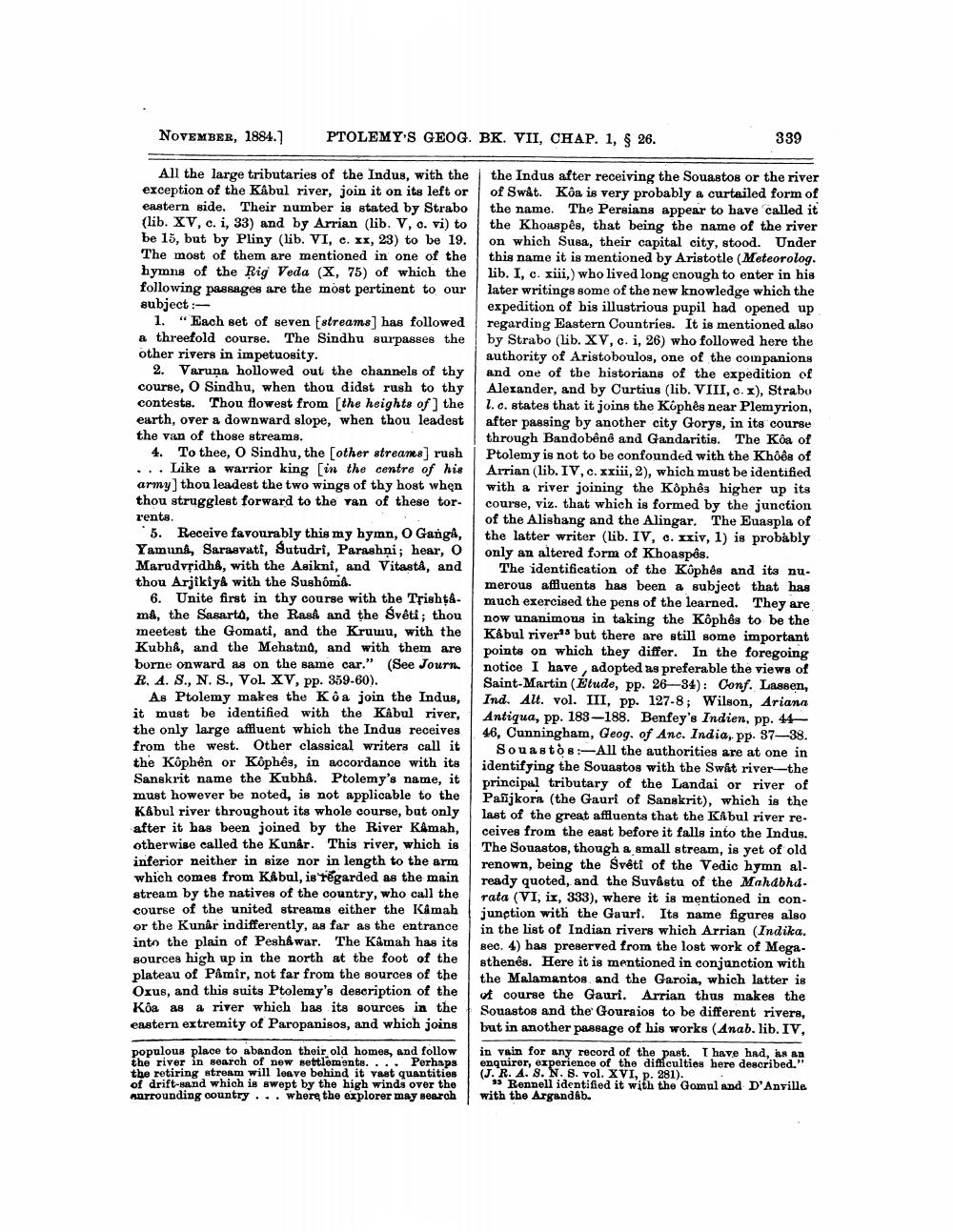________________
NOVEMBER, 1884.)
PTOLEMY'S GEOG. BK. VII, CHAP. 1, § 26.
339
All the large tributaries of the Indus, with the exception of the Kabul river, join it on its left or eastern side. Their number is stated by Strabo (lib. XV, c. i, 33) and by Arrian (lib. V, o. vi) to be 15, but by Pliny (lib. VI, c. xx, 23) to be 19. The most of them are mentioned in one of the hymns of the Rig Veda (X, 75) of which the following passages are the most pertinent to our subject :
1. "Kach set of seven streams] has followed a threefold course. The Sindhu surpasses the other rivers in impetuosity.
2. Varuna hollowed out the channels of thy course, O Sindhu, when thou didst rush to thy contests. Thou flowest from the heights of the earth, over a downward slope, when thou leadest the van of those streams.
4. To thee, O Sindhu, the other streams] rush ... Like a warrior king in the centre of his army) thou leadest the two wings of thy host when thou strugglest forward to the ran of these tor. rents.
5. Receive favourably this my hymn, O Gangå, Yamuna, Sarasvati, Sutudri, Parashni; hear, O Marudvșidha, with the Asikni, and Vitasta, and thou Arjikiya with the Sushóm.
6. Unite first in thy course with the Trishtma, the Sasarta, the Rash and the Svêti; thou meetest the Gomati, and the Krumu, with the Kubha, and the Mehatnd, and with them are borne onward as on the same car." (See Journ. R. 4. S., N. S., YOL XV, pp. 359-60).
As Ptolemy makes the Kōa join the Indus, it must be identified with the Kabul river, the only large affluent which the Indus receives from the west. Other classical writers call it the Köphên or Köphês, in accordance with its Sanskrit name the Kubhå. Ptolemy's name, it must however be noted, is not applicable to the KAbul river throughout its whole course, but only after it has been joined by the River Kamah, otherwise called the Kunar. This river, which is inferior neither in size nor in length to the arm which comes from Kabul, is regarded as the main stream by the natives of the country, who call the course of the united streams either the Kamah or the Kunâr indifferently, as far as the entrance into the plain of Peshawar. The Kámah has its sources high up in the north at the foot of the plateau of Påmir, not far from the sources of the Oxus, and this suits Ptolemy's description of the Koa as a river which has its sources in the eastern extremity of Paropanisos, and which joins
the Indus after receiving the Souastos or the river of Swåt. Kõa is very probably a curtailed form of the name. The Persians appear to have called it the Khouspês, that being the name of the river on which Susa, their capital city, stood. Under this name it is mentioned by Aristotle (Meteorolog. lib. I, c. xiii) who lived long enough to enter in his later writings some of the new knowledge which the expedition of his illustrious pupil had opened up regarding Eastern Countries. It is mentioned also by Strabo (lib. XV, c. i, 26) who followed here the authority of Aristoboulos, one of the companions and one of the historians of the expedition of Alexander, and by Curtius (lib. VIII, c. x), Strabo 1. c. states that it joins the Kóphês near Plemyrion, after passing by another city Gorys, in its course through Bando bênê and Gandaritis. The Koa of Ptolemy is not to be confounded with the Khôês of Arrian (lib. IV, c. xxiii, 2), which must be identified with a river joining the Köphês higher up its course, viz. that which is formed by the junction of the Alishang and the Alingar. The Euaspla of the latter writer (lib. IV, c. xxiv, 1) is probably only an altered form of Khoaspês.
The identification of the Küphês and its nu. merous affluents has been a subject that has much exercised the pens of the learned. They are now unanimous in taking the Kôphês to be the KAbul river but there are still some important points on which they differ. In the foregoing notice I have, adopted as preferable the views of Saint-Martin (Etude, pp. 26-34): Conf. Lassen, Ind. alt. vol. III, pp. 127-8; Wilson, Ariana Antiqua, pp. 183-188. Benfey's Indien, pp. 44 46, Cunningham, Geog. of Anc. India, pp. 37–38.
Souasto :-All the authorities are at one in identifying the Souastos with the Swat river-the principal tributary of the Landai or river of Pañjkora (the Gauri of Sanskrit), which is the last of the great affluents that the Kabul river receives from the east before it falls into the Indus. The Souastos, though a small stream, is yet of old renown, being the Sveti of the Vedic hymn already quoted, and the Suvastu of the Mahabhd. rata (VI, ix, 333), where it is mentioned in conjunction with the Gauri. Its name figures also in the list of Indian rivers which Arrian (Indika. sec. 4) has preserved from the lost work of Megasthenes. Here it is mentioned in conjunction with the Malamantos, and the Garoia, which latter is of course the Gauri. Arrian thus makes the Souastos and the Gouraios to be different rivers, but in another passage of his works (Anab. lib. IV. in vain for any record of the past. I have had, as an enquirer, experience of the difficulties here described." (J. R. A. S. N. 8. vol. XVI, p. 281).
13 Rennell identified it with the Gomul and D'Anville with the Argandab.
populous place to abandon their old homes, and follow the river in search of new settlements.... Perhaps the retiring stream will leave behind it vast quantities of drift-sand which is swept by the high winds over the Aurrounding country... where the explorer may sonrch




